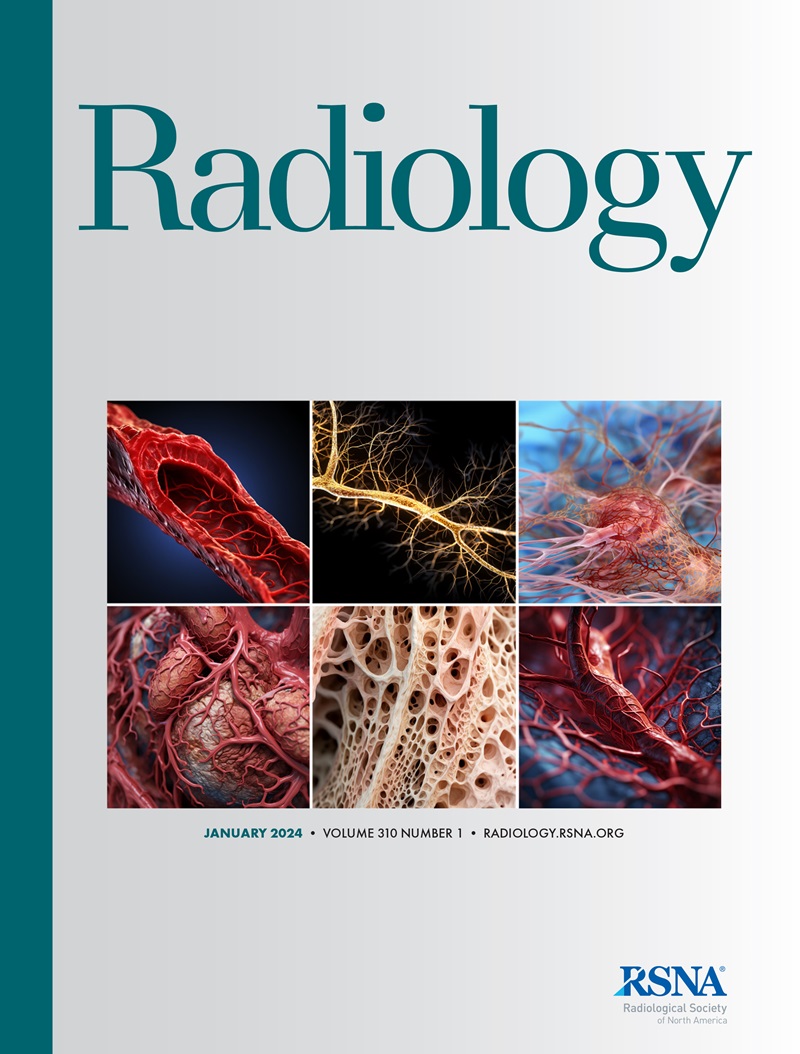A Data-Centric Approach to Deep Learning for Brain Metastasis Analysis at MRI.
IF 12.1
1区 医学
Q1 RADIOLOGY, NUCLEAR MEDICINE & MEDICAL IMAGING
Laurens Topff, Liliana Petrychenko, Neeraj Jain, Sara Lingier, Jeroen Bertels, Patricio Astudillo, Milan Prosec, Pablo Menéndez Fernández-Miranda, Olivier Gevaert, Marion Smits, Sophie Derks, Eline Verhaak, Patrick E J Hanssens, Enrique Marco de Lucas, Rodrigo Sutil, Pablo D Dominguez, Adina Negoita, Ernst Visser, David Corral Fontecha, Loes M M Braun, Dieta Brandsma, Jacob J Visser, Erik R Ranschaert, Kevin B W Groot Lipman, Regina G H Beets-Tan
下载PDF
{"title":"A Data-Centric Approach to Deep Learning for Brain Metastasis Analysis at MRI.","authors":"Laurens Topff, Liliana Petrychenko, Neeraj Jain, Sara Lingier, Jeroen Bertels, Patricio Astudillo, Milan Prosec, Pablo Menéndez Fernández-Miranda, Olivier Gevaert, Marion Smits, Sophie Derks, Eline Verhaak, Patrick E J Hanssens, Enrique Marco de Lucas, Rodrigo Sutil, Pablo D Dominguez, Adina Negoita, Ernst Visser, David Corral Fontecha, Loes M M Braun, Dieta Brandsma, Jacob J Visser, Erik R Ranschaert, Kevin B W Groot Lipman, Regina G H Beets-Tan","doi":"10.1148/radiol.242416","DOIUrl":null,"url":null,"abstract":"<p><p>Background With the increasing incidence of brain metastases (BMs), artificial intelligence models have shown promise in assisting with the detection and volumetric analysis of lesions at MRI. However, current models are limited in identifying small lesions and lack generalizability. Purpose To develop a generalizable deep learning system for detecting, segmenting, and longitudinally tracking BMs of any size at MRI. Materials and Methods In this retrospective study, a data-centric approach to deep learning model development was used. A multicenter dataset was collected, comprising pre- and/or posttreatment MRI scans from patients with BMs and MRI scans from patients with cancer without BMs (December 2015 to August 2023). Iterative data annotation by radiologists with systematic quality control increased the consistency of reference segmentations. A modified nnU-Net framework, with robust data preprocessing and augmentation, was used. Lesion-wise detection metrics and segmentation performance, Dice similarity coefficient, and normalized surface distance were evaluated. Results In total, 1985 scans from 1623 patients (mean age, 62.0 years ± 12.2 [SD]; 743 female patients, 157 patients of unknown sex), with 5552 BMs, were included. BMs were present in 64.8% of the scans (1286 of 1985), 36.0% (463 of 1286) of which were posttreatment scans. The model was trained on 1451 scans acquired on 30 different scanners. In internal testing (<i>n</i> = 223), sensitivity was 98.0% (95% CI: 96.3, 99.0; 449 of 458 lesions). In external testing (<i>n</i> = 311), sensitivity was 97.4% (95% CI: 96.2, 98.2; 935 of 960; <i>P</i> = .58), with a mean of 0.6 false positives per patient. The sensitivity remained high for all lesion sizes, including those less than 3 mm in diameter (93.3% [95% CI: 89.1, 96.0]; 196 of 210). Median Dice similarity coefficient was 0.89 and 0.90 for the internal and external test datasets, respectively (<i>P</i> = .13). Median normalized surface distance was 0.99 for both datasets. Conclusion The deep learning system demonstrated high performance and generalizability in detecting and segmenting BMs of all sizes on pre- and posttreatment MRI scans. © RSNA, 2025 <i>Supplemental material is available for this article.</i></p>","PeriodicalId":20896,"journal":{"name":"Radiology","volume":"315 3","pages":"e242416"},"PeriodicalIF":12.1000,"publicationDate":"2025-06-01","publicationTypes":"Journal Article","fieldsOfStudy":null,"isOpenAccess":false,"openAccessPdf":"https://www.ncbi.nlm.nih.gov/pmc/articles/PMC12207652/pdf/","citationCount":"0","resultStr":null,"platform":"Semanticscholar","paperid":null,"PeriodicalName":"Radiology","FirstCategoryId":"3","ListUrlMain":"https://doi.org/10.1148/radiol.242416","RegionNum":1,"RegionCategory":"医学","ArticlePicture":[],"TitleCN":null,"AbstractTextCN":null,"PMCID":null,"EPubDate":"","PubModel":"","JCR":"Q1","JCRName":"RADIOLOGY, NUCLEAR MEDICINE & MEDICAL IMAGING","Score":null,"Total":0}
引用次数: 0
引用
批量引用
Abstract
Background With the increasing incidence of brain metastases (BMs), artificial intelligence models have shown promise in assisting with the detection and volumetric analysis of lesions at MRI. However, current models are limited in identifying small lesions and lack generalizability. Purpose To develop a generalizable deep learning system for detecting, segmenting, and longitudinally tracking BMs of any size at MRI. Materials and Methods In this retrospective study, a data-centric approach to deep learning model development was used. A multicenter dataset was collected, comprising pre- and/or posttreatment MRI scans from patients with BMs and MRI scans from patients with cancer without BMs (December 2015 to August 2023). Iterative data annotation by radiologists with systematic quality control increased the consistency of reference segmentations. A modified nnU-Net framework, with robust data preprocessing and augmentation, was used. Lesion-wise detection metrics and segmentation performance, Dice similarity coefficient, and normalized surface distance were evaluated. Results In total, 1985 scans from 1623 patients (mean age, 62.0 years ± 12.2 [SD]; 743 female patients, 157 patients of unknown sex), with 5552 BMs, were included. BMs were present in 64.8% of the scans (1286 of 1985), 36.0% (463 of 1286) of which were posttreatment scans. The model was trained on 1451 scans acquired on 30 different scanners. In internal testing (n = 223), sensitivity was 98.0% (95% CI: 96.3, 99.0; 449 of 458 lesions). In external testing (n = 311), sensitivity was 97.4% (95% CI: 96.2, 98.2; 935 of 960; P = .58), with a mean of 0.6 false positives per patient. The sensitivity remained high for all lesion sizes, including those less than 3 mm in diameter (93.3% [95% CI: 89.1, 96.0]; 196 of 210). Median Dice similarity coefficient was 0.89 and 0.90 for the internal and external test datasets, respectively (P = .13). Median normalized surface distance was 0.99 for both datasets. Conclusion The deep learning system demonstrated high performance and generalizability in detecting and segmenting BMs of all sizes on pre- and posttreatment MRI scans. © RSNA, 2025 Supplemental material is available for this article.
以数据为中心的MRI脑转移分析深度学习方法。
随着脑转移(BMs)发病率的增加,人工智能模型在MRI上协助病灶的检测和体积分析方面显示出了希望。然而,目前的模型在识别小病变方面受到限制,缺乏通用性。目的开发一个通用的深度学习系统,用于在MRI上检测、分割和纵向跟踪任何大小的脑转移。在这项回顾性研究中,采用了以数据为中心的方法来开发深度学习模型。收集了一个多中心数据集,包括脑转移患者治疗前和/或治疗后的MRI扫描,以及非脑转移癌症患者的MRI扫描(2015年12月至2023年8月)。放射科医生通过系统的质量控制进行迭代数据注释,增加了参考分割的一致性。采用改进的nnU-Net框架,进行稳健的数据预处理和增强。评估了病灶检测指标和分割性能、Dice相似系数和归一化表面距离。结果共对1623例患者进行1985次扫描(平均年龄62.0岁±12.2 [SD];743例女性患者,157例性别不明患者,5552例脑转移灶。脑转移出现在64.8%(1985年1286次)的扫描中,36.0%(1286次中的463次)是治疗后扫描。该模型是在30台不同的扫描仪上获得的1451次扫描上进行训练的。在内部测试中(n = 223),灵敏度为98.0% (95% CI: 96.3, 99.0;458个病变中的449个)。在外部测试(n = 311)中,敏感性为97.4% (95% CI: 96.2, 98.2;935 / 960;P = 0.58),平均每位患者有0.6个假阳性。对于所有大小的病变,包括直径小于3mm的病变,敏感性仍然很高(93.3% [95% CI: 89.1, 96.0];196 / 210)。内部和外部测试数据集的中位数Dice相似系数分别为0.89和0.90 (P = 0.13)。两个数据集的中位数归一化表面距离为0.99。结论深度学习系统在治疗前后的MRI扫描中对各种大小脑转移的检测和分割具有较高的性能和通用性。©RSNA, 2025本文可获得补充材料。
本文章由计算机程序翻译,如有差异,请以英文原文为准。

 求助内容:
求助内容: 应助结果提醒方式:
应助结果提醒方式:


